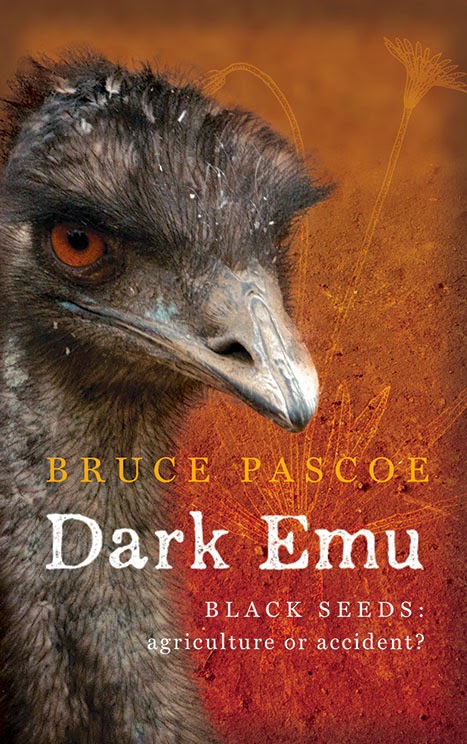 Staff Review by Chris Saliba
Staff Review by Chris Saliba In this fascinating history, Bruce Pascoe paints a lively and appealing picture of pre-contact Australia.
This short book by Bruce Pascoe sets out to persuade the reader that Aboriginal people, pre-contact with Europeans, were not exclusively hunter-gatherers. Pascoe, a novelist and historian, argues that the British self-image as a rational and superior race blinded them to the many technological innovations of the First Australians. It turns out that Aboriginal people were perhaps somewhere halfway between being hunter-gatherers and farmers. In the end, however, labelling people as hunter-gatherers or farmers or whatever seems rather futile. Aboriginal pre-contact society was obviously complex; their people highly skilled and knowledgeable. The real aim of the book, you could argue, is to demonstrate Aboriginal accomplishments and technological expertise. In this Dark Emu does a wonderful job. Pascoe uses his skills as a novelist to help us imagine what Aboriginal life may have been like. He helps us to see where we have been blind or simply ignorant.
There is much to amaze in this book. Even those who feel they have already read quite a bit of Aboriginal history will find themselves shocked at what they didn’t know. Aborigines could produce food surpluses from grain, which were stored away. These grains were ground into flour and turned into cakes. Aboriginal science was applied to poisonous foods to make them edible and nutritious. Certain nuts would be sluiced in water for many days, and given other special treatments to remove toxins. The environment was manipulated with the use of fire, creating the landscaped garden-like effect that Bill Gammage has described in his book, The Biggest Estate on Earth. Firestick farming was also used to promote growth. Harvesting the staple yam daisy, the soil would be worked in such a way to ensure the crop replenished handsomely.
The sections on Aboriginal townships and house-building are fascinating. These constructions were designed in such a way as to provide warmth and protection from adverse weather conditions, could feature indoor fires, specially designed smoke systems to repel unwanted flies, and accommodated up to 40 or so people.
Much of the information we have for pre-contact Aboriginal society comes from early explorer and settler diaries. Many of these writers, despite their natural sense of superiority, showed amazement and admiration at Aboriginal technology and know-how. British explorer Charles Sturt noted that he had mixed with many Aborigines in their camps and felt that they were “undervalued by the learned in England”. He also noted that “...I am, in candour, obliged to confess that the most unfavourable light in which I have seen them, has been when mixed up with Europeans.” Aboriginal society left unmolested was highly functional and admirable.
Two hundred years down the track, you would think that we would have all we need to know about the First Australians, but Bruce Pascoe writes that much more archaeological work needs to be done.
Dark Emu: Black Seeds: Agriculture or Accident? is an absorbing and fascinating read that breathes life into its subject. Bruce Pascoe makes it very easy to transport yourself back in time and imagine what it may have been like living before Europeans changed the continent.
Dark Emu: Black Seeds: Agriculture or Accident? by Bruce Pascoe. Published by Magabala Books. ISBN: 9781922142436 RRP: $35
To sign up for our monthly newsletter, featuring new releases, book reviews and favourite articles from around the web, click here.
No comments:
Post a Comment